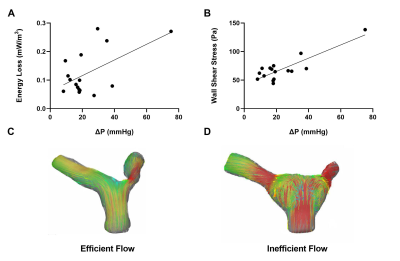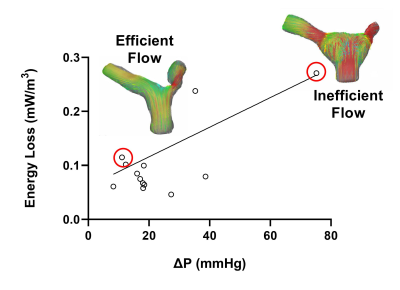Marc Delaney1, Vincent Cleveland2, Paige Mass2, Francesco Capuano3, Yue-Hin Loke4, and Laura Olivieri4
1Pediatrics, Children's National Hospital, Washington, DC, United States, 2Sheikh Zayed Institute for Pediatric Surgical Innovation, Children's National Hospital, Washington, DC, United States, 3Industrial Engineering, Universita di Napoli Federico II, Naples, Italy, 4Pediatric Cardiology, Children's National Hospital, Washington, DC, United States
1Pediatrics, Children's National Hospital, Washington, DC, United States, 2Sheikh Zayed Institute for Pediatric Surgical Innovation, Children's National Hospital, Washington, DC, United States, 3Industrial Engineering, Universita di Napoli Federico II, Naples, Italy, 4Pediatric Cardiology, Children's National Hospital, Washington, DC, United States
In repaired
transposition of the great arteries, inefficient PA blood flow, as quantified
by 4D flow CMR, is correlated to simulated RV afterload in a mock circulatory
system simulation. 4D flow CMR is a promising tool for understanding complex
hemodynamics in congenital heart disease.

Figure 1: 4D Flow-derived metrics of flow
inefficiencies correlate with simulated afterload in post-ASO DTGA. Maximum
systolic energy loss (A) and maximum wall shear stress (B) are significantly
correlated to pressure differential (ΔP) in the MCS circuit (p
= 0.021, r = 0.57 and p <0.001, r = 0.85, respectively). Streamline
visualization shows a range of flow patterns in these patients, where efficient
flow (C) has relatively low energy loss, and inefficient flow (D) demonstrates
relatively high energy loss.

Secondary Figure: In post-ASO DTGA
patients, 4D flow CMR reveals inefficient pulmonary arterial flow patterns and
quantification of flow inefficiencies by maximum systolic energy loss (mW/m3)
reveals a significant correlation to pressure differential (ΔP) in mock
circulatory system simulations (p = 0.021, r = 0.57). Representative segmented
pulmonary arteries with relatively low and high energy loss shown.
